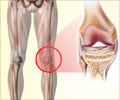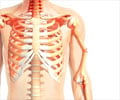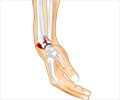Osteoporosis and fracture risk can be calculated earlier by using a new algorithm that matches genetic differences with low bone-mineral density, says study.
Highlights:
- A new genetic screen predicted that about 2 percent of those tested were at a high risk to develop osteoporosis (about 17 times more likely than others) and subsequent bone fracture (nearly twice as likely) in their lifetime
- An algorithm in the screen identified 1,362 independent genetic differences that correlated with low bone-mineral density readings among the 400,000 participants studied
The sole author of the study is Kim, and it is published in PLOS ONE.
In osteoporosis or porous bone, there is a reduction in bone mass due to bone loss or defects in bone production, or both. The weakened bone is not able to withstand the stress of slips and falls, or sometimes even regular daily activity and is susceptible to bone fracture. It affects millions of Americans and is responsible for fractures in every 2nd woman and every 4th man over the age of 50.
Osteoporosis measure by low bone-mineral density
Kim saw the correlation between people predicted to have the highest risk of low bone-mineral density and the development of osteoporosis and fracture in a chance discovery while actually investigating whether elite athletes or members of the military were at risk of bone injury during strenuous training.Researchers have earlier identified that there is a genetic component to osteoporosis, meaning you have a family history of the condition; they have also identified behavior (what you eat, how much you exercise, your weight and gender) as a significant role player in bone health.
Genetic studies on large groups of individuals have recently shown the likely involvement of hundreds of genes, each doing its own bit to either increase or decrease risk of the disease.
Radiologists use a bone-mineral density test to diagnose osteoporosis. The test uses X-rays to measure the amount of minerals, such as calcium, in a person's hip, spine or heel. However, the tests are usually only performed on people who have suffered a recent fracture from a simple fall and those with a family history of osteoporosis.
Computer algorithm developed
- Kim selected the data of nearly 400,000 people in the UK Biobank; the Biobank has a vast collection of information that is freely available to public health researchers around the world.
- He analyzed the genetic data and health information of the participants, and for each of them, he collected data on bone-mineral density, age, height, weight and, sex, as well that participant's genome sequence.
- He then developed a computer algorithm to find out if there were any naturally occurring genetic differences among people who had low bone-mineral density.
- The algorithm helped to identify 1,362 independent differences, or single-nucleotide polymorphisms, that correlated with low bone-mineral density readings.
- Kim then used a machine-learning method called LASSO, developed in 1996, to further refine the data.
Just for comparison, a much lower percentage of women (about 0.2 percent) tested will have a cancer-associated mutation in the BRCA2 gene, putting them at risk of breast cancer to about six times that of a woman without a BRCA2 mutation.
Kim is planning a clinical trial in the future to investigate whether simple preventive measures can increase the bone-mineral density of the elite athletes and select members of the military identified by the algorithm as high-risk candidates for osteoporosis and potential fracture. He is also interested in conducting a similar study among younger people who do not have any visible clinical symptoms of bone weakening.
"Fifteen million people in this country have already accessed their genome sequences using direct-to-consumer testing services," Kim said. "I think this analysis has the potential to become the standard of care in the coming years. It would be a relatively simple measure to identify those who should have their bone-mineral density tested and perhaps take steps at an early age to ensure their future bone health."
Reference:
- Osteoporosis, fracture risk predicted with genetic screen - (https://med.stanford.edu/news/all-news/2018/07/osteoporosis-fracture-risk-predicted-with-genetic-screen.html)
Source-Medindia
















